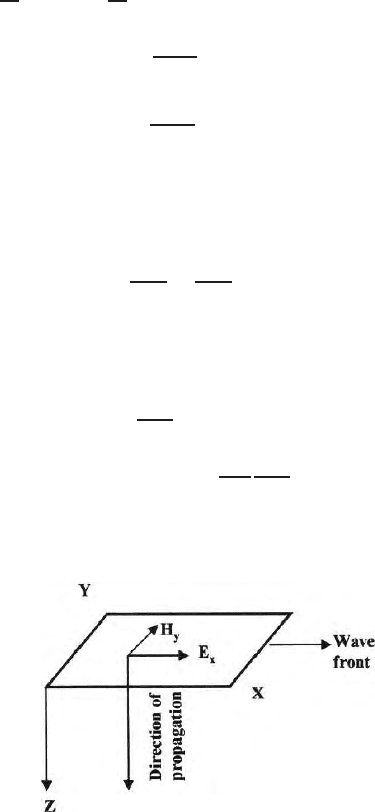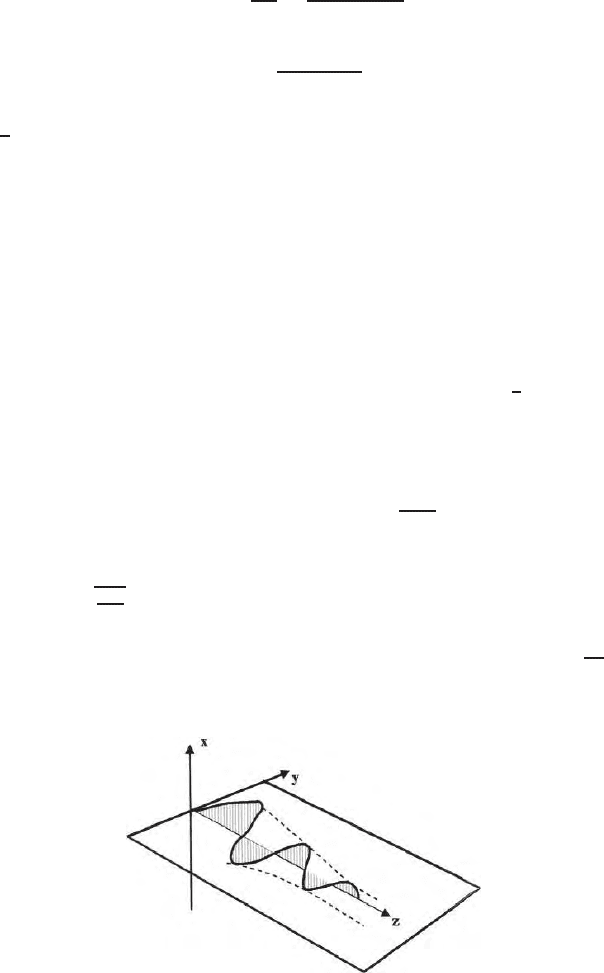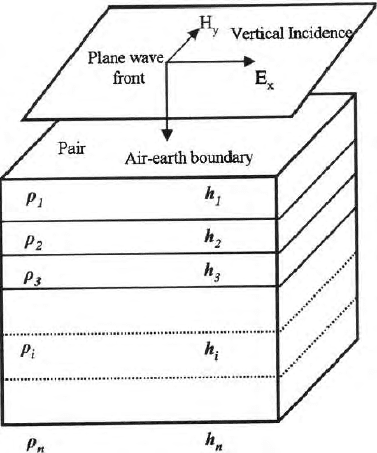Roy K.K. Potential theory in applied geophysics
Подождите немного. Документ загружается.


12.9 Poynting Vector 379
equation of continuity which is also valid for direct current, heat, fluid flow
fields, i.e.,
div
J+
∂q
v
∂t
=0. (12.147)
For a medium of finite conductivity, we have
∇.
E ×
H
=
H.
∇×
E
−
E.
∇×
H
= −µ
H
∂
H
∂t
−
E.
)
σ
E+ ∈
∂
E
∂t
*
= −
∂
∂t
1
2
µH
2
+
1
2
∈ E
2
− σE
2
. (12.148)
Equation (12.148) can be written as
s
E ×
H
ds =
Pds=−
∂
∂t
1
2
µH
2
+
1
2
∈ H
2
dv
−
v
σE
2
dv.
The last term on the right hand side is interpreted as the energy consumed
as heat in the volume for a medium of finite conductivity.

13
Electromagnetic Wave Propagation Problems
Related to Geophysics
In this chapter a basic guideline for solving electromagnetic boundar y value
problems using Helmholtz electromagnetic wave equation and the method of
separation of variables are discussed for simplest problems. The use of vector
potentials and their relation with E and H fields and application of boundary
conditions are demonstrated.
Structure of the electromagnetic boundary value problems for (i) plane
wave electromagnetics, (ii) oscillatin g vertical electric dipole in an homoge-
nous full space, (iii) oscillating vertical magnetic dipole over an homogenous
earth, (i v ) oscillating horizontal magnetic dipole over an homogenous earth,
(v) l i ne source carrying alternating current over an homogenous full space,
(vi) line source over an homogenous earth (vii) electromagnetic response
for a buried conducting horizontal cylinder in an uniform vertical field
and (viii) electromagnetic response for a buried sphere in an uniform ver-
tical field are discussed. Principle of electrody n amic similitude is included
.
13.1 Plane Wave Propagation
A source of electromagnetic wave at infin i te distance generates plane waves.
Electromagnetic waves generated due to interactions of the solar emissions
with the magnetosphere come to the surface of the earth as plane or nearly
plane waves. The electric and magnetic vectors a re mutually orthogonal in a
plane of a propagating wave front. All vibrating particles in a wave front are in
the same phase. Magnitude of electric and magnetic vectors remain invariant
in a plane wave front. The direction of propagation of electromagnetic waves
will be at right angles to the plane of the wave front.
In a rectangular coordinate system, the Helmholtz electromagnetic wave
equations are given by

382 13 Electromagnetic Wave Propagation
∇
2
E
x
= γ
2
E
x
∇
2
E
y
= γ
2
E
y
(13.1)
∇
2
E
z
= γ
2
E
z
where γ is the propagation constant. When a wave is propagating along the
z direction, as shown in Fig. 13.1, E
z
=0andH
z
= 0. For an uniform plane
wave, there will be no variation of electric and magnetic vectors with respect
to x or y i.e.,
∂
∂x
=0and
∂
∂y
= 0. Therefore, the Helmoholtz wave equation
reduces to
∂
2
E
x
∂z
2
= γ
2
E
x
(13.2)
or
∂
2
E
y
∂z
2
= γ
2
E
y
. (13.3)
If electric field is in only one direction, then it is a linearly polarized uniform
plane waves in the x and y direction. In a source free region
curl
E
x
= −iωµ
H
y
(13.4)
⇒
∂E
z
∂y
−
∂E
x
∂z
= −iωμ
H
y
. (13.5)
If
E
x
=0,then
E
y
= 0 for linearly polarized field and H
x
=0,H
z
=0with
H
y
= 0. Hence
∂E
x
∂z
= −iωµH
y
⇒ H
y
= −
1
iωµ
∂E
x
∂z
(13.6)
Similarly in other cases, where E
y
is present, the governing equations are
Fig. 13.1. Propagation of plane electromagnetic wa ves

13.1 Plane Wav e Propagation 383
∂
2
E
y
∂z
2
= γ
2
E
y
(13.7)
H
x
=
1
iωµ
∂E
y
∂z
(13.8)
These two sets of equations for plane electromagnetic waves, reflect the trans-
verse nature of electromagnetic waves. A general solution to the (13.2) is
given by
E
x
=Ae
γz
+Be
−γz
(13.9)
and from (13.5)
H
y
= −
γ
iωµ
Ae
γz
− e
−γz
(13.10)
where γ is the propagation constant and γ
2
=iωµ(σ +iω ∈).
Let γ = α +iβ then
α
2
+ β
2
+2iαβ =iωµ (σ +iω ∈). (13.11)
Equating the real and imaginary parts, we obtain
α
2
− β
2
= −ω
2
µ ∈
and
2αβ = ωµσ. (13.12)
Thus α and β can be expressed as
α = ω
)
µ ∈
2
0
1+
σ
2
ω
2
∈
2
− 1
*
1/2
(13.13)
and
β = ω
)
µ ∈
2
0
1+
σ
2
ω
2
∈
2
+1
*
1/2
. (13.14)
Case I
For
σ
2
ω
2
∈
2
<< 1
i.e., when the displacement current dominates over the conduction current,
we get
α = ω
µ ∈
2
.
1
2
.
σ
2
ω
2
∈
2
1/2
=
σ
2
0
µ
∈
(13.15)
and
β = ω
√
µ ∈
1+
1
8
σ
2
ω
2
∈
2
= ω
√
ω ∈. (13.16)

384 13 Electromagnetic Wave Propagation
For α =0,β = ω
√
µ ∈. At a very high frequency i.e., in the megahertz or
gigahertz range, displacement current dominates over conduction current and
conduction current becomes negligibly small.
Case II
For
σ
2
ω
2
∈
2
<< 1
we get
α = β =
0
ωµσ
2
. (13.17)
When conduction current dominates over the displacement current at lower
frequencies, the attenuation factor becomes a function of electrical conductiv-
ity σ, angular frequency ω and magnetic permeability µ.
13.1.1 Advancing Electromagnetic Wave
The expression for an advancing electromagnetic wave is given by
E
x
=Ae
αz
.e
iβz
+Be
−αz
.e
iβz
E
x
=
−
E
xo
e
iφ
x
.e
αz
.e
i(ωt+βz)
+
+
E
xo
e
iφ
x
.e
−αz
.e
i(ωt−βz)
(13.18)
where
+
E
xo
and
−
E
xo
are respectively the forward and backward propagating
waves. φ
x
is the initial phase. t = 0, is the initial instant of time. The real
part of this expression is given by
E
x
real
=
−
E
xo
e
αz
. cos (ωt+βz+φ
x
)
+
+
E
xo
e
−αz
cos (ωt − βz+φ
x
) . (13.19)
In an infinite space, there is no reflected component, and only the forward
propagating wave will be present.
Therefore, we can write
E
x
=E
+
xo
e
−αz
cos (ωt − βz+φ
x
) (13.20)
and
H
y
=
β
ωµ
E
+
xo
e
−αz
cos (ωt − βz+φ
x
) . (13.21)
Thus the ratio gives
E
x
H
y
=
ωµ
β
=
ωµ
ω
√
µ ∈
=
0
µ
∈
. (13.22)

13.1 Plane Wav e Propagation 385
Since E
x
is in volt/meter and H
y
is in Ampere/meter. The unit of
µ
∈
is
ohm. It is termed as the intrinsic impedance of the medium. Taking µ as the
free space magnetic permeabi li ty µ
0
=4π × 10
−7
=1.257 × 10
6
henry/meter
and the electrical permittivity as the free space electrical permittivity ∈
0
=
8.854 × 10
−12
farad/meter, we get
E
x
H
y
=
0
µ
∈
= 377 ohms. (13.23)
This is the resistance experienced by an electromagnetic wave during its prop-
agation. If electrical conductivity of a medium is zero, there will be no atten-
uation of propagating electromagnetic wave. It can travel through vacuum
and does not need any medium for its propagation. In a vacuum or in air
it travels with a velocity of light. In a conductive medium (say earth), the
velocity goes down by several order of magnitude and the velocity is con-
trolled by
µ
∈
of the medium. This particular observation that the ratio of
the electric and the transverse magnetic field gives a measure of impedance of
amediumwasknowntotheelectromagnetic research community long before
Cagniard (1953) Tikhnov (1950) prop osed the magnetotelluric theory in
geophysics.
13.1.2 Plane Wave Incidence on the Surface of the Earth
When a wave impinges normally on the surface of the earth, the wave front
will be parallel to the air-earth boundary.
Fo r a linea rly polarized EM field
E
x
= a
x
E
x
(13.24)
where
E
x
is in the x direction and
H
y
is in the y direction. The wave equation
for this problem is given by
∇
2
E
x
= γ
2
E
x
. (13.25)
For a plane wave propagating along the z-direction,
∂
∂x
=
∂
∂y
= 0, therefore
the wave equation reduces to
∂
2
E
x
∂z
2
= γ
2
E
x
(13.26)
and its solution is
E
x
=A
−γz
+Be
γz
. (13.27)
We can write
E
xo
=A
0
e
−γ
0
z
+B
0
e
γ
0
z
(13.28)

386 13 Electromagnetic Wave Propagation
for air
E
x1
=A
1
e
−γ
1
z
+B
1
e
γz
(13.29)
for earth or medium of finite conductivity.
Similarly the corresponding magnetic fields are
H
yo
=
1
η
0
A
0
e
−γ
0
z
− B
0
e
γ
0
z
(13.30)
⇒ H
y1
=
1
η
1
A
1
e
−γ
1
z
(13.31)
where η
0
and η
1
are respectively
iωµ
σ
0
and
iωµ
σ
1
.
The second term for both electric and magnetic fields will not exist in the
absence of any reflecting boundary (B
1
=0).
Now at z = 0, i.e., on the surface of the earth we have
E
x
=E
x0
and
E
x
0
=A
0
e
−γ
0
z
+
η
1
− η
0
η
1
+ η
0
e
γ
0
z
. (13.32)
In the second medium
E
x1
=A
0
2η
1
η
0
+ η
1
e
−γ
1
z
. (13.33)
Here th e reflection and the transmission coefficients are respectively given by
(i)
reflection coefficient =
η
1
− η
0
η
1
+ η
0
(13.34)
and
(ii)
transmission coefficient =
2η
1
η
1
+ η
0
. (13.35)
On the surface,
E
x
H
y
z=0
= η
1
ohm. It is termed as the surface impedance
of the medium. It is independent of the amplitude of the incident wave. In
the low frequency regime, conduction curre nt dominates over displacement
current. The propagation constant γ
1
reduces to
γ
1
=
iωµσ
1
and η
1
=
0
iωµ
σ
1
. (13.36)
The surface impedance
Z=η
1
=
0
ωµ
1
σ
1
.
√
i=
0
ωμ
1
σ
1
.e
−iπ/4
. (13.37)

13.2 Skin Depth 387
Therefore
Z
2
=
ωµ
σ
=
8π
2
× 10
−7
Tσ
(13.38)
and
ρ =
T
Z
2
8π
2
× 10
7
. (13.39)
Here ρ is resistivity of the medium and is reciprocal of σ.
π
4
is the argument of Z. This suggests that the electric and magnetic fields
are at a phase difference of 45
0
on the s u rface for a plane wave incidence over
an homogeneous earth. Moreover resistivity is prop ortional to the pro duct of
the square of the impedance ‘Z’ and time period of the EM signal ‘T’. This is
the starting point of magnetotelluric sounding.
13.2 Skin Depth
When an electromagnetic wave propagates through a medium of finite con-
ductivity, its amplitude attenuates (Fig. 13.2) and phase rotates constantly.
Depth where amplitude of an electromagnetic signal reduces to
1
e
th of its orig-
inalvalueonthesurfaceistermedasskindepthofasignalinthatmedium.
In electromagnetics , skin depth is also termed as the depth of penetration of
electromagnetic signals.
On surface of the earth, we can write the expression for electric field as
E
x1
= E
0
e
−γ
1
z
= E
0
e
−
√
iωμσz
(13.40)
⇒ E
1
=E
0
e
−z/δ
.e
iz/δ
.e
iπ/4
(13.41)
where δ =
2
ωµσ
.Thisδ is termed as the skin depth. It is a function of
electrical conductivity, magnetic permeability and the frequency of the elec-
tromagnetic signal. At a depth δ, the amplitude of the signal becomes
E
0
e
.So
the expression for the EM signal at a certain depth Z is given by
Fig. 13.2. Decay of electromagnetic w ave amplitude for its propagation through
a medium of finite conductivity

388 13 Electromagnetic Wave Propagation
Fig. 13.3. Magnetotelluric sounding over a layered earth; plane wavefront is
approaching the surface
E
1
=E
0
e
−z/δ
cos (ωt+ψ − z/δ + π/4) . (13.42)
From theoretical one dimensional magnetotelluric modeling, it is observed
that an EM signal can see a target for certain cases when it is beyond the
skin depth (Roy and Singh (1993)). Brian Spies (1989) also reported that an
EM signal can see a target when it is below the skin depth level. In general
it is treated as an estimate of the depth of penetration of the electromagnetic
signal. An EM signal amplitude decreases continuously with continuous rota-
tion of phase. Figure (13.3) shows the nature of the reduction of an EM signal
amplitude with depth.
13.3 Perturbation Centroid Frequency
In an homogeneous and isotropic medium of finite conductivity if a certain
pe rturbation is inserted at a certain depth in the form of a thin layer hav-
ing different conductivity, an EM signal of a certain frequency will see that
perturbation to the maximum extent. That is termed as the perturbation cen-
troid frequency or the depth of investigation or the depth which contributes
maximum towards the signal of a certain frequency measured on the surface.
Perturbation centroid frequency related with depth of investigation does not
have any straight forward relation with skin depth.
